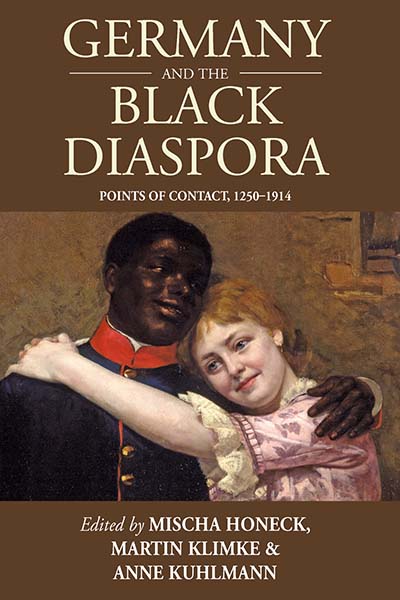Germany and the Black Diaspora: Points of Contact, 1250-1914Posted in Anthologies, Books, Europe, History, Media Archive on 2013-07-15 15:37Z by Steven |
Germany and the Black Diaspora: Points of Contact, 1250-1914
Berghahn Books
July 2013
262 pages
25 ills, 2 maps, bibliog., index
Hardback ISBN: 978-0-85745-953-4
eBook ISBN: 978-0-85745-954-1
Edited by:
Mischa Honeck, Research Fellow
German Historical Institute, Washington, D.C.
Martin Klimke, Associate Professor of History
New York University, Abu Dhabi
Anne Kuhlmann, Research Fellow in Russian History
Cultural Foundation of the German Federal States, Berlin
The rich history of encounters prior to World War I between people from German-speaking parts of Europe and people of African descent has gone largely unnoticed in the historical literature—not least because Germany became a nation and engaged in colonization much later than other European nations. This volume presents intersections of Black and German history over eight centuries while mapping continuities and ruptures in Germans’ perceptions of Blacks. Juxtaposing these intersections demonstrates that negative German perceptions of Blackness proceeded from nineteenth-century racial theories, and that earlier constructions of “race” were far more differentiated. The contributors present a wide range of Black–German encounters, from representations of Black saints in religious medieval art to Black Hessians fighting in the American Revolutionary War, from Cameroonian children being educated in Germany to African American agriculturalists in Germany’s protectorate, Togoland. Each chapter probes individual and collective responses to these intercultural points of contact.
Contents
- List of Figures
- Acknowledgments
- Introduction / Mischa Honeck, Martin Klimke, and Anne Kuhlmann
- PART I: SAINTS AND SLAVES, MOORS AND HESSIANS
- Chapter 1. The Calenberg Altarpiece: Black African Christians in Renaissance Germany / Paul Kaplan
- Chapter 2. Black Masques: Notions of Blackness in the Fifteenth and Sixteenth Centuries / Kate Lowe
- Chapter 3. Ambiguous Duty: Black Servants at German Ancien Régime Courts / Anne Kuhlmann
- Chapter 4. Real and Imagined Africans in German Court divertissements / Rashid-S. Pegah
- Chapter 5. From American Slaves to Hessian Subjects: Silenced Black Narratives of the American Revolution / Maria Diedrich
- PART II: FROM ENLIGHTENMENT TO EMPIRE
- Chapter 6. The German Reception of African American Writers in the Long Nineteenth Century / Heike Paul
- Chapter 7. “On the Brain of the Negro”: Race, Abolitionism, and Friedrich Tiedemann’s Scientific Discourse on the African Diaspora / Jeannette Eileen Jones
- Chapter 8. Liberating Sojourns? African American Travelers in Mid-Nineteenth-Century Germany / Mischa Honeck
- Chapter 9. Global Proletarians, Uncle Toms and Native Savages: The Antinomies of Black Identity in Nineteenth-Century Germany / Bradley Naranch
- Chapter 10. We Shall Make Farmers of Them Yet: Tuskegee’s Uplift Ideology in German Togoland / Kendahl Radcliffe
- Chapter 11. Education and Migration: Cameroonian School Children and Apprentices in the German Metropole, 1884-1914 / Robbie Aitken
- Afterword: Africans in Europe: New Perspectives / Dirk Hoerder
- Select Bibliography
- Notes on Contributors
- Index
